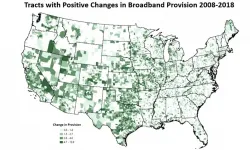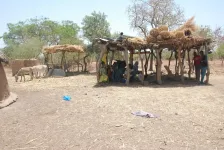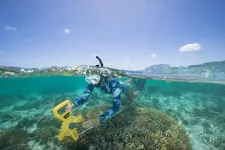Bacteria serves tasty solution to global plastic crisis
Scientists have devised a novel way of tackling the mounting issue of plastic pollution -- by using bacteria to transform plastic waste into vanilla flavoring
2021-06-10
(Press-News.org) Researchers have discovered that the common bacteria E. coli can be deployed as a sustainable way to convert post-consumer plastic into vanillin, a new study reveals.
Vanillin is the primary component of extracted vanilla beans and is responsible for the characteristic taste and smell of vanilla.
The transformation could boost the circular economy, which aims to eliminate waste, keep products and materials in use and have positive impacts for synthetic biology, experts say.
The world's plastic crisis has seen an urgent need to develop new methods to recycle polyethylene terephthalate (PET) - the strong, lightweight plastic derived from non-renewable materials such as oil and gas and widely used for packaging foods and convenience-sized juices and water.
Approximately 50 million tonnes of PET waste is produced annually, causing serious economic and environmental impacts. PET recycling is possible, but existing processes create products that continue to contribute to plastic pollution worldwide.
To tackle this problem, scientists from the University of Edinburgh used lab engineered E. coli to transform terephthalic acid - a molecule derived from PET - into the high value compound vanillin, via a series of chemical reactions.
The team also demonstrated how the technique works by converting a used plastic bottle into vanillin by adding the E. coli to the degraded plastic waste.
Researchers say that the vanillin produced would be fit for human consumption but further experimental tests are required.
Vanillin is widely used in the food and cosmetics industries, as well as the formulation of herbicides, antifoaming agents and cleaning products. Global demand for vanillin was in excess of 37,000 tonnes in 2018.
Joanna Sadler, first author and BBSRC Discovery Fellow from the School of Biological Sciences, University of Edinburgh, said: "This is the first example of using a biological system to upcycle plastic waste into a valuable industrial chemical and this has very exciting implications for the circular economy.
"The results from our research have major implications for the field of plastic sustainability and demonstrate the power of synthetic biology to address real-world challenges."
Dr Stephen Wallace, Principle Investigator of the study and a UKRI Future Leaders Fellow from the University of Edinburgh, said: "Our work challenges the perception of plastic being a problematic waste and instead demonstrates its use as a new carbon resource from which high value products can be obtained."
Dr Ellis Crawford, Publishing Editor at the Royal Society of Chemistry, said: "This is a really interesting use of microbial science at the molecular level to improve sustainability and work towards a circular economy. Using microbes to turn waste plastics, which are harmful to the environment, into an important commodity and platform molecule with broad applications in cosmetics and food is a beautiful demonstration of green chemistry."
INFORMATION:
The study, published in Green Chemistry lays the foundation for further studies to maximize vanillin production towards industrially relevant levels.
The research was funded by a BBSRC Discovery Fellowship and a UKRI Future Leaders Fellowship.
For further information, please contact: Rhona Crawford, Press and PR Office, mb: 07876391498, rhona.crawford@ed.ac.uk
ELSE PRESS RELEASES FROM THIS DATE:
2021-06-10
High-speed internet access has gone from an amenity to a necessity for working and learning from home, and the COVID-19 pandemic has more clearly revealed the disadvantages for American households that lack a broadband connection.
To tackle this problem, Michigan State University researchers have developed a new tool to smooth the collection of federal broadband access data that helps pinpoint coverage gaps across the U.S. The research was published May 26 In the journal PLOS ONE.
"Nearly 21% of students in urban areas are without at-home broadband, while 25% and 37% lack at-home broadband in suburban ...
2021-06-10
Researchers at Michigan Medicine found a subset of middle-aged men with cerebral palsy are up to 5.6 times more likely to suffer fractures than men without the disorder.
"We are not really sure why this happens," said Edward A. Hurvitz, M.D., professor and chair of the Michigan Medicine Department of Physical Therapy and Rehabilitation. "It may be related to structural differences that occur during adolescent growth, or to greater bone mineral loss at earlier age for people with cerebral palsy compared to peers."
For a study published in BONE, the team examined the timing and site of bone fractures for around ...
2021-06-10
JUNE 10, 2021, NEW YORK - A Ludwig Cancer Research study adds to growing evidence that immune cells known as macrophages inhabiting the body cavities that house our vital organs can aid tumor growth by distracting the immune system's cancer-killing CD8+ T cells.
Reported in the current issue of Cancer Cell and led by Ludwig investigators Taha Merghoub and Jedd Wolchok at Memorial Sloan Kettering (MSK) and Charles Rudin of MSK, the study shows that cavity-resident macrophages express high levels of Tim-4, a receptor for phosphatidylserine (PS), a molecule that they surprisingly ...
2021-06-10
Earlier this year, the US National Institutes of Health (NIH) acknowledged the impact of structural racism on biomedical science and committed to doing more to dismantle it. Now, in a commentary appearing June 10 in the journal Cell, NIH Director Francis Collins (@NIHDirector) and colleagues describe the NIH's UNITE initiative and how it differs from the agency's previous diversity, equity, and inclusion efforts.
The UNITE initiative was launched on February 26, 2021 and, for the first time, brings together all 27 NIH institutes to focus on structural racism. It is made up of five committees with members from across the agency and aims to accelerate efforts to address racism ...
2021-06-10
A new device that fits over a person's ears and enables non-invasive measurement of real-time changes in blood alcohol levels through the skin is presented in a proof-of-principle study in Scientific Reports.
The device, devised by Kohji Mitsubayashi and colleagues, consists of a modified pair of commercial earmuffs that collect gas released through the skin of a person's ears, and an ethanol vapour sensor. If the sensor detects ethanol vapour, it releases light, the intensity of which allows for ethanol concentrations to be calculated.
The authors used their device to continuously monitor ethanol vapour released through the ears of three male volunteers, who had consumed alcohol with a concentration of 0.4 g per kg body weight, for 140 ...
2021-06-10
A new study, published now in Nature Ecology and Evolution, draws on pollen records from tropical regions formerly claimed by the Spanish Empire in both the Atlantic and the Pacific, to test the significance and extent of forest regrowth following widespread mortality among Indigenous populations after European contact in the 15th and 16th centuries. By analyzing microscopic pollen grains preserved in lake sediments, scientists are able to build up a picture as to how environments have changed over time.
It is well documented that the arrival of Europeans in the Americas ...
2021-06-10
MELVILLE, N.Y., June 10, 2021 -- As more and more people are taking advantage of music on the go, personal audio systems are pumping up the volume to the detriment of the listener's hearing. Children, teenagers, and young adults are listening to many hours of music daily at volumes exceeding the globally recommended public health limit of 70 decibels of average leisure noise exposure for a day for a year.
During the 180th Meeting of the Acoustical Society of America, which will be held virtually June 8-10, Daniel Fink, from The Quiet Coalition, and audiologist Jan Mayes will talk about the current research into personal audio system usage and the need for public health hearing conservation policies. Their session, "Personal ...
2021-06-10
CAMBRIDGE, MA -- On Earth right now, there are about 10 trillion gigabytes of digital data, and every day, humans produce emails, photos, tweets, and other digital files that add up to another 2.5 million gigabytes of data. Much of this data is stored in enormous facilities known as exabyte data centers (an exabyte is 1 billion gigabytes), which can be the size of several football fields and cost around $1 billion to build and maintain.
Many scientists believe that an alternative solution lies in the molecule that contains our genetic information: DNA, which evolved to store massive quantities of information at very high density. A coffee mug full of DNA could theoretically store all of the world's data, says Mark Bathe, an MIT professor of biological engineering.
"We need new ...
2021-06-10
Fast Facts:
- In 2019, 409,000 people died of malaria--most were young children in sub-Saharan Africa.
- The annual economic costs of malaria to Africa alone amount to USD 12 billion.
- Through extensive fieldwork and close follow-up of the children in rural areas of Burkina Faso, the new study has led to the discovery of a molecular mechanism that alters the immune response to infection.
Abu Dhabi, UAE - June 10, 2021: In the first and largest global metabolomic study of African children before and after malaria infection, NYU Abu Dhabi Assistant Professor of Biology Youssef Idaghdour and his colleagues at the Centre National de Recherche et de Formation sur le Paludisme ...
2021-06-10
If the trend of declining coral growth continues at the current rate, the world's coral reefs may cease calcifying around 2054, a new Southern Cross University study has found.
Drawing on research from the late 1960s until now, the paper published in Communications & Environment reveals the global spatiotemporal trends and drivers of coral reef ecosystem growth (known as calcification).
One hundred and sixteen studies from 53 published papers were analysed.
"It is known that coral reefs have been degrading over time. Our study relies on historical data to quantify the current rate of decline and indicates what could be happening in the future," said project ...
LAST 30 PRESS RELEASES:
[Press-News.org] Bacteria serves tasty solution to global plastic crisis
Scientists have devised a novel way of tackling the mounting issue of plastic pollution -- by using bacteria to transform plastic waste into vanilla flavoring




